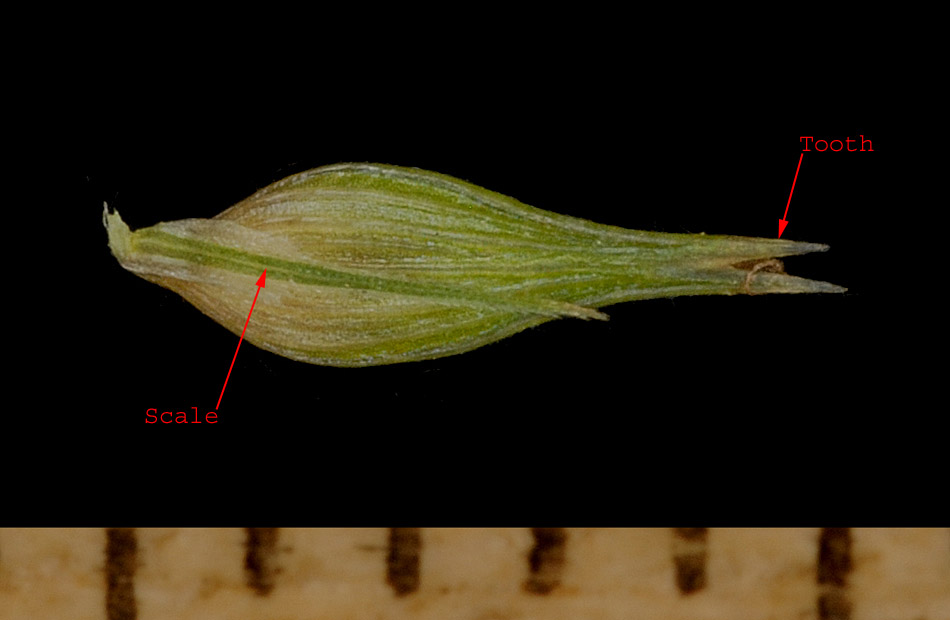 |
Pseudocyperus:
Answers to key questions in Sedges (Carex) of Saskatchewan, Fascicle 3,
Flora of Saskatchewan by Anna Leighton leading to this species. The
answers are in the order you would normally work through the key.
 |
Stigmas 3;
achenes three-sided, occasionally terete, though their shape may be
concealed by flattened perigynia. NOT [Stigmas 2; achenes
lenticular.] |
 |
Spikes 2
or more per culm, terminal and lateral; spike bracts present on lateral
spikes (except in Section Phyllostachyae), lowest bract usually evident,
often conspicuous. NOT [Spikes 1 per culm, terminal; spike bracts
absent.] |
 |
Lower
pistillate scales not bract-like or leaf-like but similar in size and
shape to individual perigynia (up to twice as long as perigynia in C.
magellanica ssp. irrigua). NOT [Lower pistillate scales resembling
green, leaf-like bracts much longer and wider than individual
perigynia.] |
 |
Perigynia
glabrous (i.e. lacking pubescence). NOT [Perigynia sparsely to densely
pubescent or puberulent (in C. pedunculata pubescence represented by
very short hairs scattered near tip; in some species of Sect.
Acrocystis, perigynia may be glabrous or virtually hairless, but all
members of this group have convexly 3-sided to terete achenes with tight
fitting perigynia and a stipe-like base about equal to beak in length).] |
 |
Beak over
0.5 mm long and usually visibly bidentate (teeth hyaline in C.
sprengelii, inconspicuous in C. viridula, very short in C. oligosperma).
NOT [Beak absent or less than 0.5 mm long; if more than 0.5 mm long,
then terminating in an orifice without teeth.] |
 |
Style
continuous with achene and persisting at maturity as a long, curved or
straight prong. NOT [Style jointed at base and deciduous from achene, if
present at maturity, breaks off readily when manipulated.] |
 |
Perigynia
shorter and usually wider, usually at most only 4 times longer than
wide; staminate spikes much longer than individual perigynia; mostly
common species. NOT [Perigynia long and narrow, (8.7) 10-12.5 mm long,
1.5-2 mm wide, about 6 times longer than wide with long tapering tip;
staminate spike about same size, or smaller than, perigynia adjacent to
it; rare northern species.] |
 |
Perigynia
20-200 per spike; leaves wider, not wiry; pistillate spikes 2-6, mostly
separate to overlapping. NOT [Perigynia 5-15 per spike; leaves 0.5-2.5
mm wide, involute, wiry; pistillate spikes few (1-2), remote (or upper
overlapping with staminate spike).] |
 |
Pistillate
spikes on filiform stalks, erect or often nodding; lower part of
pistillate scales throughout spike not much more than hyaline wings
along bottom of long awn and no wider than 1 mm. NOT [Lower pistillate
spikes short-stalked or sessile, erect to ascending; lower part of
pistillate scales more substantial, usually wider than 1 mm with awn
shorter than lower part although those at base of spike can be narrower
and long awned.] |
 |
Perigynia
spreading to reflexed at maturity, rigid and closely surrounding achene,
1-1.7 mm wide; ribs on perigynia wide with the space between ribs equal
to, or at most two times as wide as the ribs. NOT [Perigynia
ascending to spreading at maturity (sometimes reflexed at base of
spike), thin-walled and inflated around achene, 1.5-2 mm wide, almost
circular in cross section; ribs on perigynia narrow with space between
ribs at least 3 times width of ribs.] |
|

